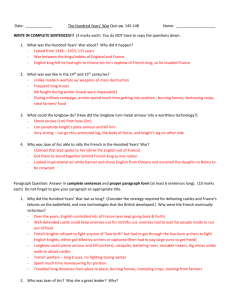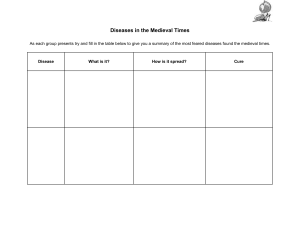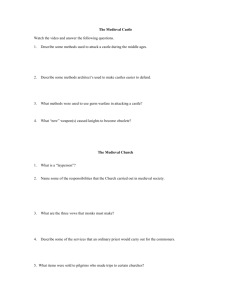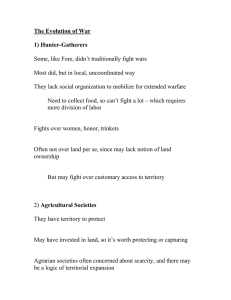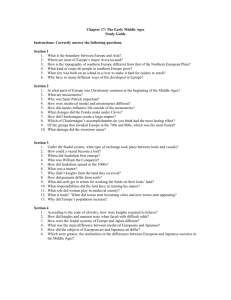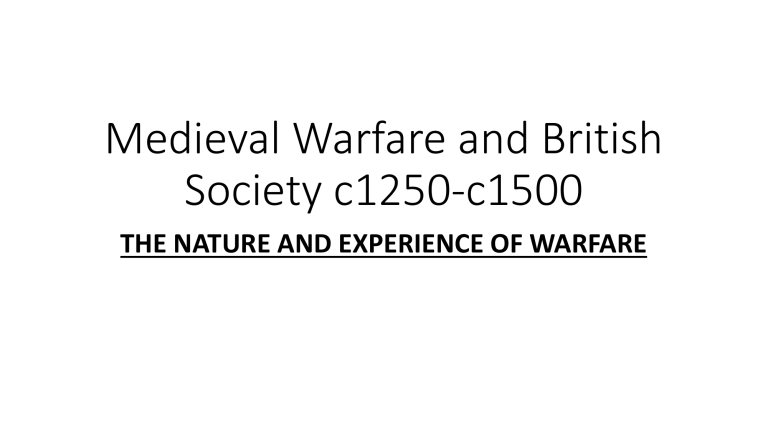
Medieval Warfare and British Society c1250-c1500 THE NATURE AND EXPERIENCE OF WARFARE The nature and experience of warfare in 1250 Notes for your Knowledge Organiser: • What was the average size and composition of armies? • How were positions of command determined? • Weapons used? • Nature of military strategy? • What different methods were used to recruit soldiers? • How were soldiers trained? • How were armies provisioned? Simon de Montfort vs PRINCE EDWARD: two useful case studies Battle of Lewes (1264) • What tactics did Simon de Montfort employ against the royal army? • How did the social attitudes of Edward’s knights contribute to his defeat? Battle of Evesham (1265) • What tactics did Prince Edward use to defeat de Montfort? • How did geography contribute to the outcome of the battle? Key question: Which weapons played little part in either battle, but became much more important in the later middle ages? How much did military equipment change in the Middle Ages? Which weapons do you think were the greatest danger to knights: (a) at the beginning of the period, c1250? (b) at the end of the period, c1500? Swords • CONTINUITY: The sword was the main weapon used by knights in handto-hand combat during the Middle Ages • CONTINUITY: Some infantrymen also carried a sword, a dagger, a club or a mace. • CHANGE: From the late fourteenth century, swords became thinner and more sharply pointed so that they could thrust between the joints of plate armour • CHANGE: the development of new weapons such as the longbow and the cannon meant that battles were less likely to be determined by cavalry charges and hand-to-hand sword fighting in the melée. Staff weapons and schiltrons • As well as swords, infantrymen often carried ‘staff’ weapons, such as pikes, spears and halberds. • The schiltron was a new formation for infantrymen carrying pikes, who formed themselves into an enormous, lethal ‘hedgehog’ formation. • Usually defensive, but the Schiltron could also be used to advance against cavalry – contributing to the decline in the use of mounted knights in medieval battles. Halberds became a common weapon in the fourteenth and fifteenth centuries, as they were inexpensive to produce, and more versatile (the hook on end could be used to pull down horsemen. The weapon was used to kill both Charles the Bold (1477) and Richard III (1485). Schiltrons were formed of around 2,000 men in several clusters, with cavalry guarding the flanks. They could be very effective against cavalry, as shown by the victory of the Scottish armies at Stirling Bridge (1297) and Bannockburn (1314). Archery The longbow The crossbow • Used in English armies from the 1290s onwards. • A range of over 350 metres, and highly accurate over a range of up to 200 metres. • Could penetrate plate armour if they landed with sufficient force (at a 90-degree angle) • Trained longbowmen could fire at a rate of 8-12 arrows per minute • Bolts could be fired with tremendous force. • In the fifteenth century, metal crossbows could fire bolts that penetrated plate armour. • However they required a mechanical device called a cranequin to draw them back, and as a result the rate of fire was very slow: only two bolts per minute. Impact of the longbow on medieval warfare • The longbow is an excellent illustration of how new technology causes changes in the history of warfare. • Played a crucial role in English victories at Falkirk (1298) and Poitiers (1356). • The influence of the longbow can be seen most clearly in the tactics used by the English army at Detail from a medieval painting of the Battle of Poitiers, showing Agincourt (see next case study). English longbowmen forcing the The role of Edward I was also very important in the development of the longbow. During his campaign in Wales, he observed their effectiveness when used by the Welsh resisters, and he was one of the first English rulers to make successful use of the longbow at Falkirk in 1298. French cavalry to retreat. 40% of all French knights were killed in the battle Development of gunpowder as a weapon of war Cannon were introduced in England in 1327, but effective range was short (100 yards), and their use was limited. Technology continued to develop during the fifteenth century: • Metal was used for the barrels and the balls (not stone) • The barrels were made much longer, increasing range, power and accuracy • Invention of trunnions – rods at each side that allowed the barrel to be lifted up or lowered, adjusting the height and distance of the fire. However: there were still serious problems with the unreliability of gunpowder in the medieval period: • James II of Scotland was killed when one of his own cannon blew up in 1460! • Cannon were slow to reload and inaccurate. • They were only really useful in sieges – they were too heavy to manoeuvre for battles Firearms (e.g. arquebus) came into use in the fifteenth century, but they were slow and complicated to load, and were unreliable, especially in damp weather. At the Battle of Bosworth (1485), cannon was used, but there is no evidence of shot from firearms at all. The development of the cannon can be shown by the fact the difference in impact during two sieges of the French town of Harfleur. In 1415, Henry V’s 12 cannon made little impact during a five-week siege. In 1449, Harfleur fell to attack by 16 French cannon in 17 days. Castle design had to be adapted: thicker and shorter walls were built to withstand artillery. Armour Use of the longbow led to changes in the protection troops wore: • Plate armour – from about 1300, chainmail was reinforced by adding plates of metal, covering the chest, shoulders, elbows, hands, knees, shins and feet • Suits of armour were developed by about 1420, covering the whole body. • Good protection against slashing swords, but only limited protection against arrows. Very little use against firearms. Note the different armour worn in the tomb engraving of Sir Roger of Trumpington (1298), compared with John of Creke (1325). John of Creke is wearing a type of helmet called a bassinet, as well as plate armour. The composition and tactics of medieval armies: continuity • Leadership roles • Kings continued to rely on their closest relatives and leading nobles as military commanders, e.g. Earl of Surrey at Falkirk; Duke of York at Agincourt • Average battlefield numbers: • Lewes (1264): Henry III’s army numbered 10,000. • Agincourt (1415): Henry V’s army numbered 8,000 • Bosworth (1485): Richard III’s army numbered 12,000 • Tactics • Limited warfare, e.g. chevauchees – short raids of 2-3,000 knights intended to terrorise the local population • Key focus on capturing castles or fortified towns. Edward I built a network of castles to subdue Wales in the 1280s, and Henry V captured Harfleur at the beginning of his campaign in 1415 Composition and tactics of medieval armies: change • Leadership roles • In 1250, about 30% of the English cavalry were noblemen. Declining use of the feudal system as the main means of recruitment mean that this had declined to just 5% in 1375. • Kings became increasingly dependent on mercenary soldiers, who often appointed their own captains – this weakened the link between social class and military command. • Average battlefield numbers: • In 1250, the average ratio of cavalry to infantry in the English army was 1:2 • By 1370, the ratio had changed to 1:3 • At Agincourt, 80% of the army were archers, and this remained the norm during the fifteenthcentury, • Tactics • The mounted knight ceased to play a dominant role in English military strategy. • The mounted charge could be effectively opposed by schiltrons, longbows, and cannons • Instead, knights tended to dismount on the battlefield, and archers were used to sow confusion in the ranks of the advancing enemy – the Battle of Dupplin Moor was a classic example of this. Recruitment and training of medieval armies • KNIGHTS • INFANTRY Key changes/continuities? Key changes/continuities? The impact of medieval warfare on civilians • What is going on in these images? • What do they suggest about the impact of warfare on ordinary civilians?

